8th Grade Unit#1 -Mechanics HONORS
8th Grade Unit#1 -Mechanics
 |
motion |
VSC CONTENT INDICATORS AND OBJECTIVES | ||||||||||||||||||||||||||||||||||||||||||||||||||||||||||||||||||||||||||||||||||||||||||||||||||||||||||||||||||||||||||||||||||||||||||||||||||||||||||||||||||||||||||||||||||||||||||||||||||||||||||||||||||||||||||||||||||||||||||||||||||||||||||||||||||||||||||||||||||||||||||||||||||||||||||||||||||||||||||||||||||||||||||||||||||||||||||||||||||||||
The shaded concepts are tested on the MSA and should be the focus of this unit. 5.8.A. Mechanics 1. Develop an explanation of motion using the relationships among time, distance, velocity, and acceleration. a. Observe, describe, and compare the motions of objects using position, speed, velocity, and the direction. b. Based on data given or collected, graph and calculate average speed using distance and time. c. Compare accelerated and constant motions using time, distance, and velocity. d. Describe and calculate acceleration using change in the speed and time. 2. Identify and relate formal ideas (Newton’s Laws) about the interaction of force and motion to real world experiences. a. Investigate and explain the interaction of force and motion that causes objects that are at rest to move. b. Demonstrate and explain, through a variety of examples, that moving objects will stay in motion at the same speed and in the same direction unless acted on by an unbalanced force. c. Investigate and collect data from multiple trials, about the motion that explain the motion that results when the same force acts on objects of different mass; and when different amounts of force act on objects of the same mass. d. Based on data collected and organized, explain qualitatively the relationship between net force applied to an object and its mass for a given acceleration. e. Calculate the net force given the mass and acceleration. 3. Recognize and explain that every object exerts gravitational force on every other object. a. Explain the difference between mass and weight. · Mass is a measure of inertia · Weight is a measure of the force of gravity. b. Describe the relationship between the gravitational force and the masses of the attracting objects. c. Describe the relationship between the gravitational force and the distance between the attracting objects. d. Recognize and cite examples showing that mass remains the same in all locations while weight may vary with a change in location (weight on Earth compared to weight on moon). e. Recognize that gravity is the force that holds planets, moons, and satellites in their orbits. 4. Recognize and explain that energy can neither be created nor destroyed; rather it changes form or is transferred through the action of forces. a. Observe and describe the relationship between the distance an object is moved by a force and the change in its potential energy or kinetic energy, such as in a slingshot, in mechanical toys, the position of an object and its potential energy.. b. Identify the relationship between the amount of energy transferred (work) to the product of the applied force and the distance moved in the direction of that force. c. Identify and describe that simple machines (levers and inclined planes) may reduce the amount of effort required to do work. · Calculate input and output work using force and distance · Demonstrate that input work is always greater than output work | ||||||||||||||||||||||||||||||||||||||||||||||||||||||||||||||||||||||||||||||||||||||||||||||||||||||||||||||||||||||||||||||||||||||||||||||||||||||||||||||||||||||||||||||||||||||||||||||||||||||||||||||||||||||||||||||||||||||||||||||||||||||||||||||||||||||||||||||||||||||||||||||||||||||||||||||||||||||||||||||||||||||||||||||||||||||||||||||||||||||
VSC SKILLS AND PROCESSES INDICATORS | ||||||||||||||||||||||||||||||||||||||||||||||||||||||||||||||||||||||||||||||||||||||||||||||||||||||||||||||||||||||||||||||||||||||||||||||||||||||||||||||||||||||||||||||||||||||||||||||||||||||||||||||||||||||||||||||||||||||||||||||||||||||||||||||||||||||||||||||||||||||||||||||||||||||||||||||||||||||||||||||||||||||||||||||||||||||||||||||||||||||
1.6-8.A Constructing Knowledge 1. Design, analyze or carry out simple investigations and formulate appropriate conclusions based on the data obtained or provided. 1.6-8.B. Applying Evidence and Reasoning 1. Review data from a simple experiment, summarize the data, and construct a logical argument about the cause-and-effect relationships in the experiment. 1.6-8.C Communicating Scientific Information 1. Develop explanations that explicitly link data from investigations conducted, selected readings and when appropriate, contributions from historical discoveries. 1.6-8.D Making Models 1. Analyze the value and the limitations of different types of models in explaining real things and processes. | ||||||||||||||||||||||||||||||||||||||||||||||||||||||||||||||||||||||||||||||||||||||||||||||||||||||||||||||||||||||||||||||||||||||||||||||||||||||||||||||||||||||||||||||||||||||||||||||||||||||||||||||||||||||||||||||||||||||||||||||||||||||||||||||||||||||||||||||||||||||||||||||||||||||||||||||||||||||||||||||||||||||||||||||||||||||||||||||||||||||
CONCEPTUAL UNDERSTANDING | ||||||||||||||||||||||||||||||||||||||||||||||||||||||||||||||||||||||||||||||||||||||||||||||||||||||||||||||||||||||||||||||||||||||||||||||||||||||||||||||||||||||||||||||||||||||||||||||||||||||||||||||||||||||||||||||||||||||||||||||||||||||||||||||||||||||||||||||||||||||||||||||||||||||||||||||||||||||||||||||||||||||||||||||||||||||||||||||||||||||
· Displacement refers to the overall change in position of an object. · Speed describes how fast an object is moving. · Velocity is speed plus direction. · The velocity of an object changes when either/both the speed or direction of motion changes. · An object moving in a circle at constant speed is accelerating because the direction of motion is continuously changing. · Acceleration is the rate at which velocity changes. · Acceleration involves increasing speed, decreasing speed, or changing direction. · Motion of an object falling freely is an example of constant acceleration-motion. · In the absence of air resistance, all objects regardless of mass fall with the same acceleration. · When the net force or unbalanced force acting on an object is zero, the object either remains at rest or moves with constant velocity. Otherwise, the object accelerates. · Inertia is the property of an object that enables it to resist change in state of motion. · The net force or unbalanced force acting on an object is directly proportional and always in the same direction as the acceleration of the body. · For a given acceleration, the net force varies proportionally with mass. The greater the mass, the more force is needed to produce a given acceleration. · For a given net force, the acceleration varies inversely with mass. The greater the mass, the smaller the acceleration produced for a given net force exerted. · For every action there is an equal and opposite reaction. · Energy is the ability to do work. · Energy can neither be created nor destroyed but can only be converted from one form into another. · Kinetic energy is the energy an object has because of its motion. The greater the speed, the greater is the kinetic energy. · Potential energy is the energy of an object due to its position. The greater the height to which an object is raised or the more a spring is stretched/ compressed, the greater is its potential energy. PRETEST-Copy these questions into your journal and answer them there (as best as you can) Under what circumstances is an object accelerating? · If an object is moving with constant speed, does it necessarily move with constant velocity? · What is the acceleration of an object if it is moving with constant velocity of 400 m/s? · What is the acceleration of an object thrown up in the air when it reaches its highest point? · What happens to the acceleration of an object thrown straight up while it is rising? · Under what circumstances is the net force acting on an object equal to zero? · What is the net force acting on an object that is moving in a circle at constant speed? · How does the acceleration of an object change with the net force acting on it? · Why do you lurch forward in a bus that suddenly slows? Why do you lurch backward when it picks up speed? · A force of gravity pulls downward on a book on a table. What force prevents the book from accelerating downward? · Why does the action-reaction pair of forces in Newton’s Third Law not cancel? · How does the force exerted by the Sun on the Earth as the Earth moves around the Sun compare to the force that the Earth exerts on the Sun? · What property of an object refers to its resistance to change in state of motion? · How does friction affect the net force on an object? · How great is the force of friction compared with your push on a crate that doesn’t move on a level floor? · If the mass of a sliding object is tripled while a constant net force is applied, by how much does the acceleration change? · If the speed of a moving object is doubled, by how much does its kinetic energy change? · What happens to the kinetic energy of an object that is thrown straight up in the air while the object is rising? Where does the kinetic energy go? · An object is dropped from a certain height above the ground. In the absence of air resistance, how does the kinetic energy of the object just before it hits the ground compare with its potential energy when it was released? · Describe the energy transformation of a swinging pendulum. FIRST BIG ASSIGNMENT - Please look up these words in dictionaries and encyclopedias and put the words and their definitions in your journal.
After you have experimented with the site, please explain in your journal what lessons did you learn ? Please read this article and answer the questions that follow
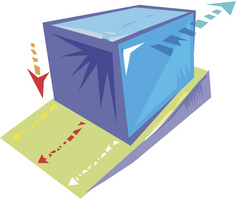 1 Look around you, and chances are you'll see things moving. Cars move. People move. Elevators move up and down in tall buildings. Shopping carts move around in supermarkets. Balls fly through the air when they are thrown. You might not think about why these things move. Cars, elevators, and balls don't just move by themselves. Something is making them move. Forces make things move. 1 Look around you, and chances are you'll see things moving. Cars move. People move. Elevators move up and down in tall buildings. Shopping carts move around in supermarkets. Balls fly through the air when they are thrown. You might not think about why these things move. Cars, elevators, and balls don't just move by themselves. Something is making them move. Forces make things move.
2 A force is a push or a pull. If you had a heavy box to move across your room, you might push it or pull it. The force would be working on the box in the same direction. It wouldn't matter to the box if you pushed it or pulled it. The amount of force needed to move the box would be the same. The direction of the force would also be the same. 3 When you push or pull a box, it is easy to see where the force is coming from. But it's harder to see forces at work when we think about a person or an animal moving. When you walk across the room, what force is making you move? Please explain in your journal what a "force" is an a 2-3 sentence paragraph 4 When you take a step, your foot is pushing down on the floor. That push is the force that makes your body move. When your foot pushes down on the floor, the floor pushes back. If the floor didn't push back, your foot wouldn't stop pushing down. You wouldn't go anywhere. You might end up standing in a hole. 5 Have you ever tried to walk in deep snow? It's much harder to walk in snow than it is on solid ground. The snow is too soft; it can't push back as hard as the ground does. Please copy this graphic organizer into your journal and complete it them there from the reading above 6 Forces always occur in pairs. A push in one direction means something is pulling in the other direction. When you push a box across the floor in your room, what other forces are pulling on it? One is friction. Rub your hands together very fast. Do you feel heat? That heat is coming from the friction between your two hands. Whenever two things are rubbing against each other, friction is the force that slows them down. Tiny bits of matter on both surfaces rub against each other. As one surface rubs in one direction, the other surface rubs in the other direction. The two opposite forces create friction. Friction slows down the motion of both surfaces. Friction also makes heat. Some of the energy of motion changes into the energy of heat.
Please copy this graphic organizer into your journal and complete it them there from the reading above 8 Gravity is another force that pulls on the box when you push it across your room. You may already know that gravity is the force that pulls a ball to the ground when you throw it. Gravity is the force that pulls all things down toward the earth. If you jump up, gravity pulls you down. If you throw a ball, gravity pulls it to the ground. When you stand on a scale, the force of gravity is pushing down on you. Please copy this graphic organizer into your journal and complete it them there from the reading above 9 As you push on the box, gravity is pulling on the box toward the ground. The two forces are not pushing and pulling in exactly opposite directions. Gravity is pulling straight down, and you are pushing sideways. The two forces are working against each other even though they are not directly opposite. 10 Why do cars have wheels? Have you ever thought about that? A wheel rolls much easier than a box would. There is less friction between a rolling wheel and the ground than there would be between a flat surface like a box and the ground. That's why wheels were invented-they make things easier to move. 11 Forces can be applied in different directions. Forces can be large or small. The direction a force is applied is the direction in which the object will move. Gravity is probably the most important force on earth. Forces are all around us! Copyright © 2011 edHelper Explain in your journal what you think a BETTER title for the reading could be and why? Please double click this web site below, and play the momentum game. Please explain in your journal about the 7 lessons you learned playing the game
Please copy these questions into your journal and answer them there
Please copy this cloze activity into your journal and answer it there
Directions: Fill in each blank with the word that best completes the reading comprehension.  Look around you, and chances are you'll see things moving. Cars move. People move. Elevators move up and down in tall buildings. Shopping carts move around in supermarkets. Balls fly through the air when they are thrown. You might not think about why these things move. Cars, elevators, and balls don't just move by themselves. Something is making them move. Forces make things move. Look around you, and chances are you'll see things moving. Cars move. People move. Elevators move up and down in tall buildings. Shopping carts move around in supermarkets. Balls fly through the air when they are thrown. You might not think about why these things move. Cars, elevators, and balls don't just move by themselves. Something is making them move. Forces make things move.A force is a push or a pull. If you had a heavy box to move across your room, you might push it or pull it. The force would be working on the box in the (1) _______________________ direction. It wouldn't matter to the box if you pushed it or pulled it. The (2) _______________________ of force needed to move the box would be the same. The direction of the force would also be the same. When you push or pull a box, it is easy to see where the force is coming from. But it's harder to see forces at work when we think about a(3) _______________________ or an animal moving. When you walk across the room, what force is making you move? When you take a step, your foot is pushing down on the floor. That push is the force that makes your (4) _______________________ move. When your(5) _______________________ pushes down on the floor, the floor pushes back. If the floor didn't push back, your foot wouldn't stop pushing down. You wouldn't go anywhere. You might end up standing in a hole. Have you ever tried to walk in (6) _______________________ snow? It's much harder to walk in snow than it is on solid ground. The snow is too soft; it can't push back as hard as the ground does. Forces always occur in pairs. A push in one direction means something is pulling in the other direction. When you push a box across the floor in your room, what other forces are pulling on it? One is friction. Rub your hands together very fast. Do you feel heat? That heat is coming from the friction between your two hands.(7) _______________________ two things are rubbing against each other, friction is the force that slows them down. Tiny bits of matter on both surfaces rub against each other. As one surface rubs in one (8) _______________________ , the other surface rubs in the other direction. The two opposite forces create friction. Friction slows down the motion of both surfaces. Friction also makes heat. Some of the energy of motion changes into the energy of heat. Gravity is another force that pulls on the box when you push it across your room. You may already know that gravity is the force that pulls a ball to the ground when you throw it. Gravity is the force that pulls all things down toward the earth. If you jump up, gravity pulls you down. If you throw a ball, gravity pulls it to the ground. When you stand on a scale, the force of gravity is pushing down on you. As you push on the box, gravity is pulling on the box toward the ground. The two forces are not pushing and pulling in exactly(9) _______________________ (10) _______________________ . Gravity is pulling (11) _______________________ down, and you are pushing sideways. The two forces are working (12) _______________________ each other (13) _______________________ though they are not directly opposite. Why do cars have wheels? Have you ever thought about that? A wheel rolls much easier (14) _______________________ a box would. There is less friction between a rolling wheel and the ground than there would be between a flat surface like a box and the ground. That's why wheels were invented-they make things easier to move. Forces can be applied in different directions. Forces can be (15) _______________________ or small. The direction a force is applied is the direction in which the object will move. Gravity is probably the most important force on (16) _______________________ . Forces are all around us! Copyright © 2011 edHelper Please copy these questions into your journal and answer them there
Please copy these questions into your journal and answer them there
Please read this article and answer the questions that follow
1 Force and motion describe everyday things that are happening all the time. Hundreds of times every day, you use force and motion. Did you just pick up a pencil? -- force and motion. Did you turn a page? -- force and motion. Raise your hand? Kick the desk in front of you? Pack your backpack? All of these are examples of force and motion. 2 Out on the playground you can see even bigger and better examples of force and motion. Climbing, jumping, running, chasing, throwing, and sliding all use force and motion. 3 Force and motion are also parts of a complicated branch of science, called physics. Now that you know what force and motion are, the next thing that you should know are some definitions. 4 The scientific definition of force is a push or a pull. When you throw a baseball, you are pushing it through the air. When you pick up a baseball bat you are pulling it up from the ground. When you hit the ball, you use both pushing and pulling motions. 5 Motion is another word with a scientific meaning. Motion means moving something from one place to another. When you used force to swing the bat and hit the baseball, they both moved from one place to another. That's what motion is. In fact, the word motion is a form of the word move. 6 Let's stick with our baseball example for a little bit longer. Some kids can hit a baseball harder than others can. You could say that their baseball travels at a faster rate.Speed is a scientific term that means the rate of motion, or how fast something travels. 7 OK, enough about baseball. Now think about rocks. Why can you throw a little pebble farther than you can throw a huge boulder? The boulder is heavier; it has more weight. 8 The Earth's gravity causes everything on Earth to have weight. Gravity is a force that pulls everything toward the center of the Earth. Gravity is holding both the pebble and the boulder down, at the same time that you are trying to throw them. Gravity is a force acting against your force. Gravity's force is stronger on heavier objects. That's why it is not too hard to throw the pebble, but very hard to throw the boulder. Weight is the measure of gravity's force. Since gravity is holding the boulder with more force than the pebble, the boulder has more weight. 9 Force, motion, speed, gravity, and weight -- everyday words with special meanings in the science called physics. Copyright © 2011 edHelper
Please explain in your journal what force is . Please explain in your journal what motion is . Please explain in your journal what speed is . Please explain in your journal what gravity is . Please explain in your journal what weight is . Explain in your journal what you think a BETTER title for the reading could be and why? Please copy these questions into your journal and answer them there
Please copy this cloze activity into your journal and answer it there | ||||||||||||||||||||||||||||||||||||||||||||||||||||||||||||||||||||||||||||||||||||||||||||||||||||||||||||||||||||||||||||||||||||||||||||||||||||||||||||||||||||||||||||||||||||||||||||||||||||||||||||||||||||||||||||||||||||||||||||||||||||||||||||||||||||||||||||||||||||||||||||||||||||||||||||||||||||||||||||||||||||||||||||||||||||||||||||||||||||||
Force and Motion By Sharon Fabian |  | |||||||||||||||||||||||||||||||||||||||||||||||||||||||||||||||||||||||||||||||||||||||||||||||||||||||||||||||||||||||||||||||||||||||||||||||||||||||||||||||||||||||||||||||||||||||||||||||||||||||||||||||||||||||||||||||||||||||||||||||||||||||||||||||||||||||||||||||||||||||||||||||||||||||||||||||||||||||||||||||||||||||||||||||||||||||||||||||||||||
Directions: Fill in each blank with the word that best completes the reading comprehension.
Force and motion (1) _______________________ everyday things that are happening all the time. Hundreds of times every day, you use force and motion. Did you just pick up a pencil? -- force and motion. Did you turn a page? -- (2) _______________________ and motion. (3) _______________________ your hand? Kick the desk in front of you? Pack your backpack? All of these are examples of force and motion.
Out on the playground you can see (4) _______________________ bigger and better examples of force and motion. Climbing, jumping, running, chasing, throwing, and sliding all use force and motion.
Force and motion are also parts of a complicated branch of science, called physics. Now that you know what force and motion are, the next thing that you should know are some definitions.
The scientific definition of force is a push or a pull. When you throw a baseball, you are pushing it (5) _______________________ the air. When you pick up a baseball bat you are pulling it up from the ground. When you hit the ball, you use both pushing and pulling motions.
Motion is another word with a (6) _______________________ (7) _______________________ . Motion means (8) _______________________ something from one place to(9) _______________________ . When you used force to swing the bat and hit the baseball, they both (10) _______________________ from one place to another. That's what motion is. In fact, the (11) _______________________ motion is a form of the word (12) _______________________ .
Let's stick with our baseball example for a little bit longer. Some kids can hit a baseball harder than others can. You could say that their baseball travels at a (13) _______________________ rate. Speed is a scientific (14) _______________________ that means the rate of motion, or how fast something travels.
OK, enough about baseball. Now think about rocks. Why can you throw a little pebble farther than you can throw a huge boulder? The boulder is heavier; it has more weight.
The Earth's gravity causes everything on Earth to have weight. Gravity is a force that pulls everything toward the (15) _______________________ of the Earth. Gravity is holding both the pebble and the boulder down, at the same time that you are trying to throw them. Gravity is a force acting against your force. Gravity's force is stronger on heavier objects. That's why it is not too hard to throw the pebble, but very hard to throw the boulder. Weight is the (16) _______________________ of gravity's force. Since gravity is holding the boulder with more force than the pebble, the boulder has more weight.
Force, motion, speed, gravity, and weight -- (17) _______________________ (18) _______________________ with special (19) _______________________ in the science called physics.
Copyright © 2011 edHelper
Please read this article and answer the questions that follow
Newton's Three Laws of Motion By Sharon Fabian |  |
1 Isaac Newton was born in 1643. His family was wealthy, so in some ways he had advantages over other kids his age, but in other ways he was disadvantaged. Isaac's father had died before Isaac was born, and he was raised by his grandmother and other relatives. At first he probably was not encouraged to learn much in school. He didn't pay attention in school, and was described as lazy. It was only after an uncle encouraged him to prepare to go on to college that he began to take an interest in school and to develop his talents. One of the skills he developed while still in school was making model machines, including clocks and windmills. In college he began studying the latest theories in math. Soon he was coming up with theories of his own, and today Sir Isaac Newton is well known for his three laws of motion as well as for other scientific breakthroughs.
Please copy this graphic organizer into your journal and complete it them there from the reading above
Please copy these questions into your journal and answer them there
 | Date ___________________ |
|
58. | Comparing the lines of ____ showed us which magnet was stronger. | |
59. | Oil is used to reduce ____ between metals parts in a car. | |
60. | Temperature is actually a measure of how much heat ____ there is. | |
61. | _ ___ is conserved according to the las of conservation of mass. | |
62. | Force can be increased by increasing mass and or ____. | |
63. | Ellen saw lights in the ____. | |
64. | We asked neighbors to sign Mr. Smith's petition to get ____ bumps on his street. | |
65. | He used brute ____ to open the window when it was stuck. | |
66. | When you rub your hands together it creates ____ and friction creates heat. | |
67. | Volcanoes produce geothermal ____. | |
68. | Because of its ____, the elephant was difficult to move. | |
69. | Heat and ____ can force some electrons to leave one atom and move to another. | |
70. | When the volleyball player hit the ball, the ____ caused it to go in the opposite direction. | |
71. | _ ___ between the two pieces of metal caused them to grow very hot. | |
72. | Skiing down hill at great ____ is so much fun. |
2 Here are Sir Isaac Newton's three laws of motion.
3 Law 1 - An object moving in a straight line will continue moving in a straight line, unless acted on by an outside force. Also, an object at rest will stay at rest. The word for this is inertia.
4 Law 2 - Force will cause a change in the motion of an object. The change in motion depends on the amount of force and the mass of the object. There is a formula for this F=ma (force equals mass times acceleration).
5 Law 3 - For each action, there is an equal and opposite reaction.
Please copy this graphic organizer into your journal and complete it them there from the reading above
6 These three laws will make more sense, and be a lot more interesting, if you do some experiments to demonstrate each law. Maybe Sir Isaac did some similar experiments when he was testing out his theories.
7 To demonstrate the first law, you might want to try the old trick of pulling the tablecloth out from under the dishes on the table. If you do it just right, you will remove the table cloth without causing the dishes to crash to the floor. Then again, maybe you wouldn't want to try that one, even though Newton's first law says that objects at rest, like the dishes, will stay at rest.
8 Another way to demonstrate inertia is to show what can happen when you don't wear your seat belt. A safe way to demonstrate this is with a small toy truck, a clay figure, a ramp, and a brick. Place the little clay figure in the toy truck. Place the brick just a short distance past the end of the ramp. The toy truck can roll down the ramp until it hits the brick. When it hits the brick, the truck will stop suddenly, but the clay figure will keep moving forward and fly out of the truck because of inertia.
Newton's First Law of Motion
Newton's First Law
In a previous chapter of study, the variety of ways by which motion can be described (words, graphs, diagrams, numbers, etc.) was discussed. In this unit (Newton's Laws of Motion), the ways in which motion can be explained will be discussed. Isaac Newton (a 17th century scientist) put forth a variety of laws that explain why objects move (or don't move) as they do. These three laws have become known as Newton's three laws of motion. The focus of Lesson 1 is Newton's first law of motion - sometimes referred to as the law of inertia.
An object at rest stays at rest and an object in motion stays in motion with the same speed and in the same direction unless acted upon by an unbalanced force.
There are two parts to this statement - one that predicts the behavior of stationary objects and the other that predicts the behavior of moving objects. The two parts are summarized in the following diagram.
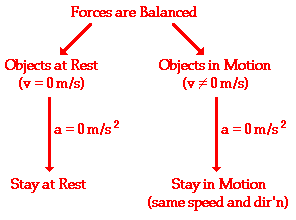
 The behavior of all objects can be described by saying that objects tend to "keep on doing what they're doing" (unless acted upon by an unbalanced force). If at rest, they will continue in this same state of rest. If in motion with an eastward velocity of 5 m/s, they will continue in this same state of motion (5 m/s, East). If in motion with a leftward velocity of 2 m/s, they will continue in this same state of motion (2 m/s, left). The state of motion of an object is maintained as long as the object is not acted upon by an unbalanced force. All objects resist changes in their state of motion - they tend to "keep on doing what they're doing."
The behavior of all objects can be described by saying that objects tend to "keep on doing what they're doing" (unless acted upon by an unbalanced force). If at rest, they will continue in this same state of rest. If in motion with an eastward velocity of 5 m/s, they will continue in this same state of motion (5 m/s, East). If in motion with a leftward velocity of 2 m/s, they will continue in this same state of motion (2 m/s, left). The state of motion of an object is maintained as long as the object is not acted upon by an unbalanced force. All objects resist changes in their state of motion - they tend to "keep on doing what they're doing."Suppose that you filled a baking dish to the rim with water and walked around an oval track making an attempt to complete a lap in the least amount of time. The water would have a tendency to spill from the container during specific locations on the track. In general the water spilled when:
- the container was at rest and you attempted to move it
- the container was in motion and you attempted to stop it
- the container was moving in one direction and you attempted to change its direction.
 The water spills whenever the state of motion of the container is changed. The water resisted this change in its own state of motion. The water tended to "keep on doing what it was doing." The container was moved from rest to a high speed at the starting line; the water remained at rest and spilled onto the table. The container was stopped near the finish line; the water kept moving and spilled over container's leading edge. The container was forced to move in a different direction to make it around a curve; the water kept moving in the same direction and spilled over its edge. The behavior of the water during the lap around the track can be explained by Newton's first law of motion.
The water spills whenever the state of motion of the container is changed. The water resisted this change in its own state of motion. The water tended to "keep on doing what it was doing." The container was moved from rest to a high speed at the starting line; the water remained at rest and spilled onto the table. The container was stopped near the finish line; the water kept moving and spilled over container's leading edge. The container was forced to move in a different direction to make it around a curve; the water kept moving in the same direction and spilled over its edge. The behavior of the water during the lap around the track can be explained by Newton's first law of motion.Everyday Applications of Newton's First Law
There are many applications of Newton's first law of motion. Consider some of your experiences in an automobile. Have you ever observed the behavior of coffee in a coffee cup filled to the rim while starting a car from rest or while bringing a car to rest from a state of motion? Coffee "keeps on doing what it is doing." When you accelerate a car from rest, the road provides an unbalanced force on the spinning wheels to push the car forward; yet the coffee (that was at rest) wants to stay at rest. While the car accelerates forward, the coffee remains in the same position; subsequently, the car accelerates out from under the coffee and the coffee spills in your lap. On the other hand, when braking from a state of motion the coffee continues forward with the same speed and in the same direction, ultimately hitting the windshield or the dash. Coffee in motion stays in motion.
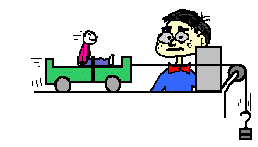 Have you ever experienced inertia (resisting changes in your state of motion) in an automobile while it is braking to a stop? The force of the road on the locked wheels provides the unbalanced force to change the car's state of motion, yet there is no unbalanced force to change your own state of motion. Thus, you continue in motion, sliding along the seat in forward motion. A person in motion stays in motion with the same speed and in the same direction ... unless acted upon by the unbalanced force of a seat belt. Yes! Seat belts are used to provide safety for passengers whose motion is governed by Newton's laws. The seat belt provides the unbalanced force that brings you from a state of motion to a state of rest. Perhaps you could speculate what would occur when no seat belt is used.
Have you ever experienced inertia (resisting changes in your state of motion) in an automobile while it is braking to a stop? The force of the road on the locked wheels provides the unbalanced force to change the car's state of motion, yet there is no unbalanced force to change your own state of motion. Thus, you continue in motion, sliding along the seat in forward motion. A person in motion stays in motion with the same speed and in the same direction ... unless acted upon by the unbalanced force of a seat belt. Yes! Seat belts are used to provide safety for passengers whose motion is governed by Newton's laws. The seat belt provides the unbalanced force that brings you from a state of motion to a state of rest. Perhaps you could speculate what would occur when no seat belt is used.Assignment=Please click this website, then read and watch the animation
After you have experimented with the site, please explain
in your journal what lessons did you learn ?
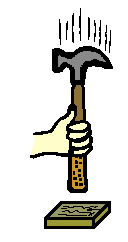
There are many more applications of Newton's first law of motion. Several applications are listed below. Perhaps you could think about the law of inertia and provide explanations for each application.
- Blood rushes from your head to your feet while quickly stopping when riding on a descending elevator.
- The head of a hammer can be tightened onto the wooden handle by banging the bottom of the handle against a hard surface.
- A brick is painlessly broken over the hand of a physics teacher by slamming it with a hammer. (CAUTION: do not attempt this at home!)
- To dislodge ketchup from the bottom of a ketchup bottle, it is often turned upside down and thrusted downward at high speeds and then abruptly halted.
- Headrests are placed in cars to prevent whiplash injuries during rear-end collisions.
- While riding a skateboard (or wagon or bicycle), you fly forward off the board when hitting a curb or rock or other object that abruptly halts the motion of the skateboard.
Assignment=Please click this website, then read and watch the animation
After you have experimented with the site, please explain
in your journal what lessons did you learn ?
|
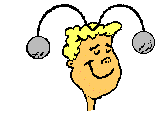 Acquire a metal coat hanger for which you have permission to destroy. Pull the coat hanger apart. Using duct tape, attach two tennis balls to opposite ends of the coat hanger as shown in the diagram at the right. Bend the hanger so that there is a flat part that balances on the head of a person. The ends of the hanger with the tennis balls should hang low (below the balancing point). Place the hanger on your head and balance it. Then quickly spin in a circle. What do the tennis balls do? Acquire a metal coat hanger for which you have permission to destroy. Pull the coat hanger apart. Using duct tape, attach two tennis balls to opposite ends of the coat hanger as shown in the diagram at the right. Bend the hanger so that there is a flat part that balances on the head of a person. The ends of the hanger with the tennis balls should hang low (below the balancing point). Place the hanger on your head and balance it. Then quickly spin in a circle. What do the tennis balls do? |
Please copy this graphic organizer into your journal and complete it them there from the two paragraphs of reading above
9 For the second law, there are many demonstrations that you can do. Anything that involves using a force to move an object would demonstrate Newton's second law. You might want to try an experiment in which you change the amount of force that you use, or change the mass of the objects that you try to move. For example, you could set up a little seesaw, made from a ruler balanced on a pencil. Try objects of different weights at the one end, and drop something on the other end to see which object moves the farthest. Or, try dropping the objects from different heights.
Please copy this graphic organizer into your journal and complete it them there from the reading above
10 The third law is fun to demonstrate. One way is with a basketball and roller skates. Two kids, each wearing roller skates, stand facing each other and throw a basketball back and forth. As each kid pushes the basketball forward, he will roll backwards on his skates. That is the equal and opposite reaction described in the third law. You can also build a balloon racer to demonstrate the third law. Tie a string between two chairs, pretty far apart. Put an empty pen case or a section of a straw on the string so that it can slide along the string. Now blow up a balloon but don't tie it. Carefully tape the balloon to the pen case or straw, then let go. The action of the air shooting out of the balloon causes a reaction of the balloon racing across the string towards the opposite end.
10 The third law is fun to demonstrate. One way is with a basketball and roller skates. Two kids, each wearing roller skates, stand facing each other and throw a basketball back and forth. As each kid pushes the basketball forward, he will roll backwards on his skates. That is the equal and opposite reaction described in the third law. You can also build a balloon racer to demonstrate the third law. Tie a string between two chairs, pretty far apart. Put an empty pen case or a section of a straw on the string so that it can slide along the string. Now blow up a balloon but don't tie it. Carefully tape the balloon to the pen case or straw, then let go. The action of the air shooting out of the balloon causes a reaction of the balloon racing across the string towards the opposite end.
Please copy this graphic organizer into your journal and complete it them there from the reading above
Newton's Third Law of Motion
Newton's Third Law
A force is a push or a pull upon an object that results from its interaction with another object. Forces result from interactions! As discussed in Lesson 2, some forces result from contact interactions (normal, frictional, tensional, and applied forces are examples of contact forces) and other forces are the result of action-at-a-distance interactions (gravitational, electrical, and magnetic forces). According to Newton, whenever objects A and B interact with each other, they exert forces upon each other. When you sit in your chair, your body exerts a downward force on the chair and the chair exerts an upward force on your body. There are two forces resulting from this interaction - a force on the chair and a force on your body. These two forces are called action and reaction forces and are the subject of Newton's third law of motion. Formally stated, Newton's third law is:
For every action, there is an equal and opposite reaction.
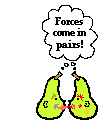 The statement means that in every interaction, there is a pair of forces acting on the two interacting objects. The size of the forces on the first object equals the size of the force on the second object. The direction of the force on the first object is opposite to the direction of the force on the second object. Forcesalways come in pairs - equal and opposite action-reaction force pairs.
The statement means that in every interaction, there is a pair of forces acting on the two interacting objects. The size of the forces on the first object equals the size of the force on the second object. The direction of the force on the first object is opposite to the direction of the force on the second object. Forcesalways come in pairs - equal and opposite action-reaction force pairs.A variety of action-reaction force pairs are evident in nature. Consider the propulsion of a fish through the water. A fish uses its fins to push water backwards. But a push on the water will only serve to accelerate the water. Since forces result from mutual interactions, the water must also be pushing the fish forwards, propelling the fish through the water. The size of the force on the water equals the size of the force on the fish; the direction of the force on the water (backwards) is opposite the direction of the force on the fish (forwards). For every action, there is an equal (in size) and opposite (in direction) reaction force. Action-reaction force pairs make it possible for fish to swim.
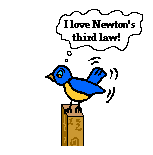 Consider the flying motion of birds. A bird flies by use of its wings. The wings of a bird push air downwards. Since forces result from mutual interactions, the air must also be pushing the bird upwards. The size of the force on the air equals the size of the force on the bird; the direction of the force on the air (downwards) is opposite the direction of the force on the bird (upwards). For every action, there is an equal (in size) and opposite (in direction) reaction. Action-reaction force pairs make it possible for birds to fly.
Consider the flying motion of birds. A bird flies by use of its wings. The wings of a bird push air downwards. Since forces result from mutual interactions, the air must also be pushing the bird upwards. The size of the force on the air equals the size of the force on the bird; the direction of the force on the air (downwards) is opposite the direction of the force on the bird (upwards). For every action, there is an equal (in size) and opposite (in direction) reaction. Action-reaction force pairs make it possible for birds to fly.Consider the motion of a car on the way to school. A car is equipped with wheels that spin in a clockwise direction. As the wheels spin clockwise, they grip the road and push the road backwards. Since forces result from mutual interactions, the road must also be pushing the wheels forward. The size of the force on the road equals the size of the force on the wheels (or car); the direction of the force on the road (backwards) is opposite the direction of the force on the wheels (forwards). For every action, there is an equal (in size) and opposite (in direction) reaction. Action-reaction force pairs make it possible for cars to move along a roadway surface.
Check Your Understanding
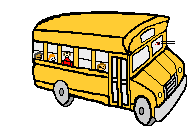 1. While driving down the road, a firefly strikes the windshield of a bus and makes a quite obvious mess in front of the face of the driver. This is a clear case of Newton's third law of motion. The firefly hit the bus and the bus hits the firefly. Which of the two forces is greater: the force on the firefly or the force on the bus?
1. While driving down the road, a firefly strikes the windshield of a bus and makes a quite obvious mess in front of the face of the driver. This is a clear case of Newton's third law of motion. The firefly hit the bus and the bus hits the firefly. Which of the two forces is greater: the force on the firefly or the force on the bus?Trick Question! Each force is the same size. For every action, there is an equal ... (equal!). The fact that the firefly splatters only means that with its smaller mass, it is less able to withstand the larger acceleration resulting from the interaction. Besides, fireflies have guts and bug guts have a tendency to besplatterable. Windshields don't have guts. There you have it.
2. For years, space travel was believed to be impossible because there was nothing that rockets could push off of in space in order to provide the propulsion necessary to accelerate. This inability of a rocket to provide propulsion is because ...
a. ... space is void of air so the rockets have nothing to push off of.b. ... gravity is absent in space.c. ... space is void of air and so there is no air resistance in space.d. ... nonsense! Rockets do accelerate in space and have been able to do so for a long time.
It is a common misconception that rockets are unable to accelerate in space. The fact is that rockets do accelerate. There is indeed nothing for rockets to push off of in space - at least nothing which is external to the rocket. But that's no problem for rockets. Rockets are able to accelerate due to the fact that they burn fuel and push the exhaust gases in a direction opposite the direction which they wish to accelerate.
DID YOU GET THE SAME ANSWER? Please explain what you did in your journal
It is a common misconception that rockets are unable to accelerate in space. The fact is that rockets do accelerate. There is indeed nothing for rockets to push off of in space - at least nothing which is external to the rocket. But that's no problem for rockets. Rockets are able to accelerate due to the fact that they burn fuel and push the exhaust gases in a direction opposite the direction which they wish to accelerate.
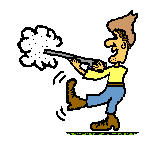 3. Many people are familiar with the fact that a rifle recoils when fired. This recoil is the result of action-reaction force pairs. A gunpowder explosion creates hot gases that expand outward allowing the rifle to push forward on the bullet. Consistent with Newton's third law of motion, the bullet pushes backwards upon the rifle. The acceleration of the recoiling rifle is ...
3. Many people are familiar with the fact that a rifle recoils when fired. This recoil is the result of action-reaction force pairs. A gunpowder explosion creates hot gases that expand outward allowing the rifle to push forward on the bullet. Consistent with Newton's third law of motion, the bullet pushes backwards upon the rifle. The acceleration of the recoiling rifle is ...a. greater than the acceleration of the bullet.b. smaller than the acceleration of the bullet.c. the same size as the acceleration of the bullet.
The force on the rifle equals the force on the bullet. Yet, acceleration depends on both force and mass. The bullet has a greater acceleration due to the fact that it has a smaller mass. Remember: acceleration and mass are inversely proportional.
4. In the top picture (below), Kent Budgett is pulling upon a rope that is attached to a wall. In the bottom picture, the Kent is pulling upon a rope that is attached to an elephant. In each case, the force scale reads 500 Newton. Kent is pulling ...
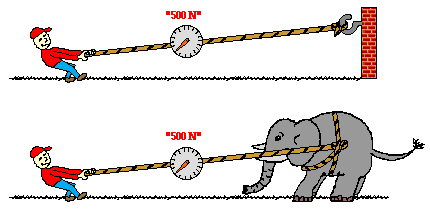
a. with more force when the rope is attached to the wall.b. with more force when the rope is attached to the elephant.c. the same force in each case.
Kent is pulling with 500 N of force in each case. The rope transmits the force from Kent to the wall (or to the elephant) and vice versa. Since the force of Kent pulling on the wall and the wall pulling on Kent are action-reaction force pairs, they must have equal magnitudes. Inanimate objects such as walls can push and pull.
DID YOU GET THE SAME ANSWER? Please explain what you did in your journal
11 If you don't feel like doing experiments, you can always observe Newton's laws of motion in another location, an amusement park. Roller coasters, merry-go-rounds, and bumper cars all follow Newton's three laws of motion, and are part of the science of force and motion.
Copyright © 2011 edHelper
Explain in your journal what you think a BETTER title for the reading could be and why?
Please copy these questions into your journal and answer them there
 | Date ___________________ |
|
73. | _ ___ is conserved according to the las of conservation of mass. | |
74. | When Charles gets home from school and plops down on the couch, he does not have much ____ to get up and do the list his mother left for him. | |
75. | The tide rises and falls because of the pull of the moon's ____. | |
76. | _ ___ divided by volume equals density. | |
77. | This flow of ____ is an energy chain. | |
78. | _ ___ prevents sneakers from slipping on a gym floor. | |
79. | The ____ of the wind made me fall back. | |
80. | Will the ____ of gravity pull the comet to Earth? | |
81. | _ ___ keeps the dishes on the table when I pull the table cloth off. | |
82. | Weightlessness in space is caused by the lack of ____. | |
83. | We asked neighbors to sign Mrs. Leftwich's petition to get ____ bumps on her street. | |
84. | When the fire alarm rang, the visitors lingered in the hall because they did not realize the ____ of the situation. | |
85. | Solar ____ can be converted to electricity on both small and large scale. | |
86. | The jet was unable to take off because it failed to reach proper ____. |
Assignment=Please click this website, then hit"run" and play the game
After you have experimented with the site, please explain in your journal what lessons did you learn in order to be a success?
_____________________________ |  | Date ___________________ |
|
| ||||
|
| ||||
|
| ||||
|
|
Copy this cloze assignment below into your journal and answer them there
Newton's Three Laws of Motion By Sharon Fabian |  |
Directions: Fill in each blank with the word that best completes the reading comprehension.
Isaac Newton was born in 1643. His family was (1) _______________________ , so in some ways he had advantages over other kids his age, but in other ways he was disadvantaged. Isaac's father had died before Isaac was (2) _______________________ , and he was raised by his grandmother and other relatives. At first he probably was not encouraged to learn much in school. He didn't pay attention in school, and was described as lazy. It was only after an uncle encouraged him to (3) _______________________ to go on to college that he began to take an interest in school and to (4) _______________________ his talents. One of the skills he (5) _______________________ while still in school was making model machines, including clocks and windmills. In college he began studying the latest theories in (6) _______________________ . Soon he was coming up with theories of his own, and today Sir Isaac Newton is well known for his three laws of motion as well as for other scientific breakthroughs.
Here are Sir Isaac Newton's three laws of motion.
Law 1 - An object moving in a straight line will continue moving in a straight line, unless acted on by an outside force. Also, an object at rest will stay at rest. The word for this is inertia.
Law 2 - Force will (7) _______________________ a change in the motion of an object. The change in motion depends on the amount of force and the mass of the object. There is a(8) _______________________ for this F=ma (force equals mass times acceleration).
Law 3 - For each action, there is an equal and opposite reaction.
These three laws will make more sense, and be a lot more interesting, if you do some experiments to demonstrate each law. Maybe Sir Isaac did some similar experiments when he was(9) _______________________ out his theories.
To demonstrate the first law, you might want to try the old trick of pulling the tablecloth out from under the dishes on the table. If you do it just right, you will remove the table cloth without(10) _______________________ the dishes to crash to the floor. Then again, maybe you wouldn't want to try that one, even though Newton's first law says that objects at rest, like the dishes, will stay at rest.
Another way to demonstrate (11) _______________________ is to show what can happen when you don't wear your seat belt. A safe way to demonstrate this is with a small toy truck, a clay figure, a ramp, and a brick. Place the little clay figure in the toy truck. Place the brick just a short distance past the end of the ramp. The toy truck can roll down the ramp until it hits the brick. When it hits the brick, the truck will stop suddenly, but the clay figure will keep moving forward and fly out of the truck because of inertia.
For the second law, there are many demonstrations that you can do. Anything that involves using a force to move an object would demonstrate Newton's second law. You might want to try an experiment in which you change the amount of force that you use, or change the mass of the objects that you try to move. For example, you could set up a little seesaw, made from a(12) _______________________ balanced on a pencil. Try objects of different weights at the one end, and drop something on the other end to see (13) _______________________ object moves the farthest. Or, try dropping the objects from different heights.
The third law is fun to demonstrate. One way is with a basketball and roller skates. Two kids, each wearing roller skates, stand facing each other and throw a basketball back and forth. As each kid pushes the basketball forward, he will roll backwards on his skates. That is the equal and opposite reaction described in the third law. You can also build a balloon racer to demonstrate the third law. Tie a string between two chairs, pretty far apart. Put an empty pen (14) _______________________ or a (15) _______________________ of a straw on the string so that it can slide along the string. Now blow up a balloon but don't tie it. Carefully tape the balloon to the pen case or straw, then let go. The action of the air shooting out of the balloon(16) _______________________ a reaction of the balloon racing across the string towards the opposite end.
If you don't feel like doing experiments, you can always observe Newton's laws of motion in another (17) _______________________ , an amusement park. Roller coasters, merry-go-rounds, and bumper cars all follow Newton's three laws of (18) _______________________ , and are part of the science of force and motion.
Copyright © 2011 edHelper
Please copy these questions into your journal and answer them there
 | Date ___________________ |
|
87. | Many rocks cause ____ in lakes and oceans. | |
88. | The ____ of the magnet allowed us to pick up metal objects. | |
89. | You have ____ when your body resists change. | |
90. | We gazed at the craggy mountaintop in the ____. | |
91. | New ____ limits are not always easily enforceable. | |
92. | Three types of ____ are rolling, sliding, and fluid (air). | |
93. | Weight is different from mass in that mass does not involve gravitational ____. | |
94. | A cannon ball has more ____ than a beach ball. | |
95. | The drivers were oblivious of the ____ limit as they rushed to the hospital. | |
96. | The invention of the computer caused an ____ of changes in our world. | |
97. | We studied the ____ of celestial objects orbiting the sun. | |
98. | The ____ of the wind was breathtaking. | |
99. | Joe will change the ____ of his car by using the brakes. |
_____________________________ |  | Date ___________________ ( |
1. | inertia |
2. | example |
3. | math |
4. | formula |
5. | seesaw |
6. | testing |
7. | interest |
8. | wealthy |
9. | formula |
Please read this article and answer the questions that follow
It's Dynamic! Force and Energy By Trista L. Pollard |  |
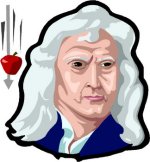 1 According to Sir Isaac Newton, bodies at rest will remain at rest, and bodies in motion will remain in motion. However, in the science of dynamics,force and energy are important factors that can affect the motion of bodies. Force is the push or pull of an object that tends to produce acceleration of the body's motion in the direction of the force. Force also changes the size and shape of a body. There are four basic forces in nature. However, in relation to machines and vehicles, we will only talk about the forces related to gravity and motion. Gravity is the force of attraction between any two objects. This force depends on the mass or weight of each object and their distance from each other. Gravitational force is always attractive; however, over increasing distances, the force decreases, but it is still measurable. Gravity is the force that keeps all beings and objects on earth. If we traveled into space, we would experience an environment that has zero gravitational pull. Another concept related to gravity is free fall. Free fall occurs when objects fall downward toward earth due to earth's gravitational pull. If two different objects with different masses were in a free fall from the same height, they would have the same acceleration regardless of their masses. I wonder if a free falling feather and a bowling ball would reach the ground at the same time. I don't recommend trying this experiment; I was just wondering.
1 According to Sir Isaac Newton, bodies at rest will remain at rest, and bodies in motion will remain in motion. However, in the science of dynamics,force and energy are important factors that can affect the motion of bodies. Force is the push or pull of an object that tends to produce acceleration of the body's motion in the direction of the force. Force also changes the size and shape of a body. There are four basic forces in nature. However, in relation to machines and vehicles, we will only talk about the forces related to gravity and motion. Gravity is the force of attraction between any two objects. This force depends on the mass or weight of each object and their distance from each other. Gravitational force is always attractive; however, over increasing distances, the force decreases, but it is still measurable. Gravity is the force that keeps all beings and objects on earth. If we traveled into space, we would experience an environment that has zero gravitational pull. Another concept related to gravity is free fall. Free fall occurs when objects fall downward toward earth due to earth's gravitational pull. If two different objects with different masses were in a free fall from the same height, they would have the same acceleration regardless of their masses. I wonder if a free falling feather and a bowling ball would reach the ground at the same time. I don't recommend trying this experiment; I was just wondering.Please copy this graphic organizer into your journal and complete it them there from the reading above
2 Momentum is the force or speed of movement. This occurs when force is applied to an already moving object. Once the force is applied, the object's momentum may increase or decrease. When force is not applied to a moving body, its momentum will not change. Think about water flowing down a steep hill. As the water flows down the hill, it gains momentum to the point where its velocity or speed will increase. When your little brother goes running across the grass and tries to run up the hill to the playground, you will notice his momentum decrease as the hill becomes steeper. As he runs toward the top, his velocity will decrease, and he will probably be tired once he gets to the playground.
Please copy this graphic organizer into your journal and complete it them there from the reading above
3 There are other forces that affect the movement of objects. Friction is a force that resists the movement between two objects that are touching. Increasing the friction on a moving object will decrease the object's velocity. An example would be when you go "skating" in your socks on your kitchen floor. Since there is very little friction, you should move rather quickly. However, as soon as you try to continue your sock skating on the rug, you will notice that your motion almost comes to a halt. The friction between your socks and the rug is greater than the friction was between your socks and the smooth kitchen floor. Therefore, your motion has decreased. Tension is another type of force that involves objects like springs. Tension is the force that is exerted or produced by a stretched object. The tighter the object is pulled, the greater the tension. Sometimes the tension becomes too great causing the object to break. Springs, due to their design, are able to withstand huge amounts of tension. It is for this reason they are used as parts of machines and other objects. Now that we have talked about force, we will talk about energy.
Please copy this graphic organizer into your journal and complete it them there from the reading above
4 Energy is the ability of an object or being to do work or to make something happen. The following are different forms of energy: heat, light, sound, electrical, chemical, and mechanical. When it comes to motion, two forms of energy are very important. Potential energy is the stored energy in an object that when released can change into another form of energy. Kinetic energy is the energy of motion, and it depends on the mass of the object and the object's speed or velocity. Imagine the basketball you left at the top of the stairs in your house. Although that basketball is at rest, it has potential energy. This means that it has the potential to move. Now if a force (your sister's foot) happens to push the ball (that's right, she kicked it down the stairs), the basketball potential energy has turned into kinetic energy. The basketball's energy of position has changed to energy of motion. When the basketball meets a force that will cause it to rest, its energy of motion will change back into energy of position.
Please copy this graphic organizer into your journal and complete it them there from the reading above
5 Another example of changes between potential and kinetic energy is a playground swing. As you sit on the swing, flying back and forth in the air, you probably noticed that as you swung higher, your motion became faster. When your body flies upward, the swing's kinetic energy is continuously being changed to potential energy. This is why you may appear to slow down as you reach the top of your swing. The higher you go, the greater the potential energy. As you make your way downward, the increased potential energy will convert to an increased amount of kinetic energy. The whole process begins again, until you get tired of swinging.
Please copy this graphic organizer into your journal and complete it them there from the reading above
6 Although energy can be converted from one form to another, it can not be created or destroyed. This principle is the Law of Conservation of Energy . Simply put, if an object is not affected by an outside force, then the energy within that object remains constant. The laws of motion and the principles of force and energy are important to keep in mind when we begin to study how machines and vehicles move in our world. As we journey through the unit of transportation these laws and principles will reemerge like road signs on an endless highway.
Explain in your journal what you think a BETTER title for the reading could be and why?
Please explain what the "Law of Conservation of Energy" is in your journal in a 3-5 sentence paragraphCopyright © 2011 edHelper
_____________________________ |  | Date ___________________ |
|
| ||||
|
| ||||
|
| ||||
|
|
Stopping Distance of a Hot Wheels Car
Consider the motion of a Hot Wheels car beginning from rest at an elevated position. The Hot Wheels car rolls down a hill and begins its motion across a level surface. Along the level surface, the Hot Wheels car collides with a box and skids to a stop over a given distance. How could work and energy be utilized to analyze the motion of the Hot Wheels car? Would the total mechanical energy of the Hot Wheels car be altered in the process of rolling down the incline or in the process of skidding to a stop? Or would the total mechanical energy of the Hot Wheels car merely be conserved during the entire motion?
Of course the answers to these questions begin by determining whether or not external forces are doing work upon the car. If external forces do work upon the car, the total mechanical energy of the car is not conserved; the initial amount of mechanical energy is not the same as the final amount of mechanical energy. On the other hand, if external forces do not do work upon the car, then the total mechanical energy is conserved; that is, mechanical energy is merely transformed from the form of potential energy to the form of kinetic energy while the total amount of the two forms remains unchanged.
While the Hot Wheels car moves along the incline, external forces do not do work upon it. This assumes that dissipative forces such as air resistance have a negligible affect on the car's motion. This is a reasonable assumption for the low speeds of the car and its streamline characteristics. Since external forces do not do work on the car, the total mechanical energy of the car is conserved while moving along the incline. As the work-energy bar charts in the animation below depict, energy is transformed from potential energy (the stored energy of position) to kinetic energy (the energy of motion). The car gains speed as it loses height. The bar chart also depicts the fact that the total amount of mechanical energy is always the same; when the two forms are added together, the sum is unchanging.
When the Hot Wheels car collides with the box and skids to a stop, external forces do a significant amount of work upon the car. The force of friction acts in the direction opposite the car's motion and thus does negative work upon the car. This negative works contributes to a loss in mechanical energy of the car. In fact, if 0.40 Joules of mechanical energy are lost, then -0.40 Joules of work are done upon the car. As this work is done, the mechanical energy of the car (in the form of kinetic energy) is transformed into non-mechanical forms of energy such as sound and heat.
Analyze the animation and use the principles of work and energy to answer the given questions.
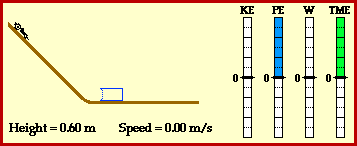
Questions to Ponder:
1. Use energy conservation principles to determine the speed of a 0.050-kg Hot Wheels car that descends from a height of 0.60 meter to a height of 0.00 meter. Assume negligible air resistance.
***Since PE intitial = KE final (ie. all energy in the form of height is converted to energy in the form of motion to
Use this formula m*g*h= 0.5*m*v^2
2. Use energy conservation principles to determine the speed of a 0.050-kg Hot Wheels car that descends halfway down a 0.60-meter high hill (i.e., to a height of 0.30 meters). Assume negligible air resistance.
3. If the mass of the Hot Wheels car was twice as great (0.100 kg), then what would be the speed at the bottom of the 0.60-meter high hill?
4. If the 0.050-kg Hot Wheels car is brought to a rest over a distance of 0.40 meters, then what is the magnitude of the frictional force acting upon the car?
_____________________________ |  | Date ___________________ |
_____________________________ |  | Date ___________________ |
Copy this cloze assignment below into your journal and answer them there
It's Dynamic! Force and Energy By Trista L. Pollard |  |
Directions: Fill in each blank with the word that best completes the reading comprehension.
 According to Sir Isaac Newton, bodies at rest will remain at rest, and bodies in motion will remain in motion. However, in the science of(1) _______________________ , force and energy are important factors that can affect the motion of bodies. Force is the push or pull of an object that tends to(2) _______________________ acceleration of the body's motion in the direction of the force. Force also changes the size and shape of a body. There are four basic forces in nature. (3) _______________________ , in relation to machines and vehicles, we will only talk about the forces related to gravity and motion.(4) _______________________ is the force of attraction between any two objects. This force depends on the (5) _______________________ or weight of each object and their distance from each other. Gravitational force is always attractive; however, over (6) _______________________ distances, the force(7) _______________________ , but it is still measurable. Gravity is the force that keeps all beings and objects on earth. If we (8) _______________________ into space, we would experience an environment that has zero gravitational pull. Another concept related to gravity is free fall. Free fall occurs when objects fall downward toward earth due to earth's gravitational pull. If two different objects with different masses were in a free fall from the same height, they would have the same (9) _______________________ regardless of their(10) _______________________ . I wonder if a free falling feather and a bowling ball would reach the ground at the same time. I don't recommend trying this experiment; I was just wondering.
According to Sir Isaac Newton, bodies at rest will remain at rest, and bodies in motion will remain in motion. However, in the science of(1) _______________________ , force and energy are important factors that can affect the motion of bodies. Force is the push or pull of an object that tends to(2) _______________________ acceleration of the body's motion in the direction of the force. Force also changes the size and shape of a body. There are four basic forces in nature. (3) _______________________ , in relation to machines and vehicles, we will only talk about the forces related to gravity and motion.(4) _______________________ is the force of attraction between any two objects. This force depends on the (5) _______________________ or weight of each object and their distance from each other. Gravitational force is always attractive; however, over (6) _______________________ distances, the force(7) _______________________ , but it is still measurable. Gravity is the force that keeps all beings and objects on earth. If we (8) _______________________ into space, we would experience an environment that has zero gravitational pull. Another concept related to gravity is free fall. Free fall occurs when objects fall downward toward earth due to earth's gravitational pull. If two different objects with different masses were in a free fall from the same height, they would have the same (9) _______________________ regardless of their(10) _______________________ . I wonder if a free falling feather and a bowling ball would reach the ground at the same time. I don't recommend trying this experiment; I was just wondering.Momentum is the force or speed of movement. This occurs when force is applied to an already moving object. Once the force is applied, the object's momentum may(11) _______________________ or decrease. When force is not applied to a moving body, its momentum will not change. Think about water flowing down a steep hill. As the water flows down the hill, it gains momentum to the point where its velocity or speed will increase. When your little brother goes running across the grass and tries to run up the hill to the playground, you will notice his momentum decrease as the hill becomes steeper. As he runs toward the top, his velocity will (12) _______________________ , and he will probably be tired once he gets to the playground.
There are other forces that affect the movement of objects. Friction is a force that resists the movement between two objects that are touching. Increasing the friction on a moving object will decrease the object's velocity. An example would be when you go "skating" in your socks on your kitchen floor. Since there is very little friction, you should move rather quickly. However, as soon as you try to continue your sock skating on the rug, you will notice that your motion almost comes to a halt. The friction between your socks and the rug is greater than the friction was between your socks and the smooth kitchen floor. Therefore, your motion has (13) _______________________ . Tension is another type of force that involves objects like springs. Tension is the force that is exerted or (14) _______________________ by a stretched object. The tighter the object is pulled, the greater the tension. Sometimes the tension becomes too great causing the object to break. Springs, due to their design, are able to (15) _______________________ huge amounts of tension. It is for this reason they are used as parts of machines and other objects. Now that we have talked about force, we will talk about energy.
Energy is the ability of an object or being to do work or to make something happen. The following are different forms of energy: heat, light, sound, (16) _______________________ , chemical, and mechanical. When it comes to motion, two forms of energy are very important. Potential energy is the stored energy in an object that when released can change into another form of energy. Kinetic energy is the energy of motion, and it depends on the mass of the object and the object's speed or velocity. Imagine the basketball you left at the top of the stairs in your house. Although that basketball is at rest, it has potential energy. This means that it has the potential to move. Now if a force (your sister's foot) happens to push the ball (that's right, she kicked it down the stairs), the basketball potential energy has turned into kinetic energy. The basketball's energy of position has changed to energy of motion. When the basketball meets a force that will cause it to rest, its energy of motion will change back into energy of position.
Another example of changes between potential and kinetic energy is a playground swing. As you sit on the swing, flying back and forth in the air, you probably noticed that as you swung higher, your motion became faster. When your body flies (17) _______________________ , the swing's kinetic energy is continuously being changed to potential energy. This is why you may appear to slow down as you reach the top of your swing. The higher you go, the greater the potential energy. As you make your way downward, the (18) _______________________ potential energy will (19) _______________________ to an increased amount of kinetic energy. The whole process begins again, until you get tired of swinging.
Although energy can be (20) _______________________ from one form to another, it can not be created or destroyed. This principle is the Law of Conservation of Energy . Simply put, if an object is not (21) _______________________ by an outside force, then the energy within that object remains constant. The laws of motion and the principles of force and energy are important to keep in mind when we begin to study how machines and vehicles move in our world. As we journey through the unit of transportation these laws and principles will(22) _______________________ like road signs on an endless highway.
Copyright © 2011 edHelper
_____________________________ |  | Date ___________________ |
POST TEST - Please copy into your journal and answer these questions there.
Under what circumstances is an object accelerating?
· If an object is moving with constant speed, does it necessarily move with constant velocity?
· What is the acceleration of an object if it is moving with constant velocity of 400 m/s?
· What is the acceleration of an object thrown up in the air when it reaches its highest point?
· What happens to the acceleration of an object thrown straight up while it is rising?
· Under what circumstances is the net force acting on an object equal to zero?
· What is the net force acting on an object that is moving in a circle at constant speed?
· How does the acceleration of an object change with the net force acting on it?
· Why do you lurch forward in a bus that suddenly slows? Why do you lurch backward when it picks up speed?
· A force of gravity pulls downward on a book on a table. What force prevents the book from accelerating downward?
· Why does the action-reaction pair of forces in Newton’s Third Law not cancel?
· How does the force exerted by the Sun on the Earth as the Earth moves around the Sun compare to the force that the Earth exerts on the Sun?
· What property of an object refers to its resistance to change in state of motion?
· How does friction affect the net force on an object?
· How great is the force of friction compared with your push on a crate that doesn’t move on a level floor?
· If the mass of a sliding object is tripled while a constant net force is applied, by how much does the acceleration change?
· If the speed of a moving object is doubled, by how much does its kinetic energy change?
· What happens to the kinetic energy of an object that is thrown straight up in the air while the object is rising? Where does the kinetic energy go?
· An object is dropped from a certain height above the ground. In the absence of air resistance, how does the kinetic energy of the object just before it hits the ground compare with its potential energy when it was released?
· Describe the energy transformation of a swinging pendulum.
_____________________________ |  | Date ___________________ |
|
| ||||
|
| ||||
|
| ||||
|
|
|
| ||||
|
| ||||
|
| ||||
|
|
|
| ||||
|
| ||||
|
| ||||
|
|





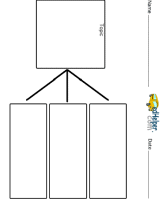
 Student Extras
Student Extras
No comments:
Post a Comment